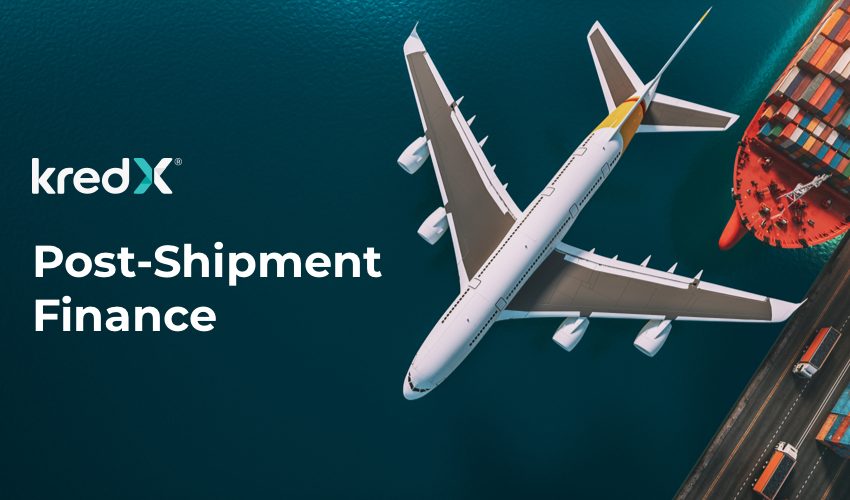
What Exporters Need to Know About Post-Shipment Finance
In global trading, an exporter needs to wait a significant amount before receiving payments for items shipped to an overseas importer. This can restrain their cash flow, which can seriously jeopardise the optimal functioning of the company. In such a situation, businesses have the scope to opt for post-shipment finance for exporters.
In export financing, financial lenders sanction funds to the creditworthy exporters against Letters of Credit or non-LC bills like a Document against Acceptance or a Document against Payment. Consequently, exporters can rest assured as they have a reliable solution to their liquidity problem.
With supply-chain-based short-term financing solutions enjoying growing popularity in recent years, post-shipment credit has become a staple of the business sector. Notably, leading FinTech services such as KredX are now providing post-shipment finance to exporters.
How Does Post Shipment Credit Function?
As mentioned above, the lengthy-time period between shipping goods and receiving the remittance can be counterproductive for exporters. In particular, a lack of working capital can hinder their growth and expansion plans. Companies need to have a stable discretionary income to invest in raw materials, acquire new tools or pay wages.
Lending institutions provide post-shipment finance for exporters as a loan against the products they have already shipped. In India, this credit is provided to the business owners from the date of extending credit after shipment of goods to the realisation date of export proceeds. As per the RBI guidelines, this stipulated period of export proceeds realisation is 15 months from the export date.
In this transaction model, financial institutions sanction funds against export sales receivables. To avail the financing, the exporters must present evidence of the overseas shipment. As the financiers have control over the commercial documents associated with the goods shipped, this loan is self-liquidating in most cases.
Notably, post-shipment finance for exporters is provided for three different types of exports:
- Physical Export: In this instance, the lender provides credit to the actual exporter, who is mentioned by name in the trade documents.
- Capital Goods and Project Export: Under this scheme, funds are sanctioned in the name of the foreign importer. Although, the money gets disbursed directly to the domestic exporter.
- Deemed Export: The finance is offered to the supplier of goods and services, which are sent to the designated agencies.
Importance of Post Shipment Finance
Even other than offering an immediate and prompt solution to the budget-crunch issue of the exporters, post-shipment finance for exporters is immensely important for other aspects of the business too.
For instance, this model offers a time-efficient option to the exporters regarding converting their accounts receivables to cash. As a result, these exporters get more flexibility in extending grace periods to their overseas buyers. Consequently, these businesses build towards sustainable growth thanks to their improved Customer Lifetime Value.
Moreover, businesses do not need to risk losing their assets as collateral is not required for this loan. Small-scale businesses in India often struggle to access traditional credit, as the lack of collateral makes lenders deem them high-risk borrowers. Export financing provides the crucial financial assistance needed by exporters ensuring the acquisition of funds without indemnity.
Types Of Post Shipment Credit
There is a wide array of options available for realising the post-shipment finance for exporters, such as:
- Advance against a bill for collection
- Finance against export on a consignment basis
- Advance against claims of duty drawback
- Finance against undrawn balances
- Purchased export bills
- Discounted export bills
- Negotiated export bills
Who Are Eligible for Post Shipment Finance for Exporters?
All kinds of exporters, including market and manufacturing exporters, export and trading houses and manufacturers who supply merchant exporters, export houses and trading houses, can avail this credit facility.
Both individuals and companies are eligible to acquire this funding. In other words, if any legal entity is associated with the export of goods, that entity is permitted to get post-shipment finance for exporters.
Which Documents Are Required to Get Post Shipment Credit?
As evidence of the goods being shipped, one must submit shipping documents like:
- Original copy of the Letter of Credit
- Import Export Code [IEC] certificate
- Bill of lading
- Airway bill
- Commercial invoice
- Packing list
- Certificate of origin
- Inspection certificate
- Insurance certificate
It is important to note that other than these shipping documents, a lender might ask for additional paperwork on a case-to-case basis.
Who Provides Post Shipment Finance for Exporters?
There are three major sources from which exporters can get a post-shipment funding:
- Banks: Different kinds of banks, such as the nationalised, cooperative, foreign, rural or private ones, are legally capable of extending this service to the exporters.
- Export-Import (Exim) Bank of India: The Exim Bank is a government-owned financial institution which can sanction funds against shipped goods to business owners.
- NBFCs: Non-Banking financial corporations have also revitalised export-specific financial services by offering invoice discounting, working capital loans, etc.
Bottom Line
Export financing in India continues to reshape the import-and-export market of this country. Notably, business owners now do not have to solely depend on traditional lenders like banks to avail post-shipment finance for exporters. With leading fintech services like KredX sanctioning funds against already shipped goods, exporters do not have to worry about cash tangled up in accounts receivables.



